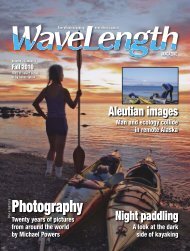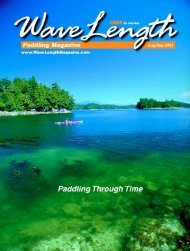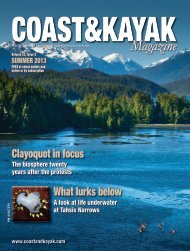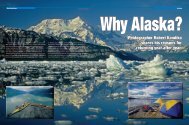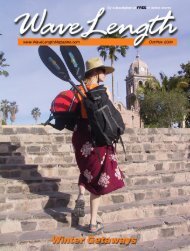download - WaveLength Paddling Magazine
download - WaveLength Paddling Magazine
download - WaveLength Paddling Magazine
You also want an ePaper? Increase the reach of your titles
YUMPU automatically turns print PDFs into web optimized ePapers that Google loves.
Vacuum bagging has the resin added to<br />
a dry laminate, then the bag is added and<br />
the resin is then spread through the laminate<br />
with rubber or hard plastic squeegees.<br />
The glass fabric or cloth to resin ratio is<br />
only slightly higher than the best hand laminate<br />
but the reduction of resin does decrease<br />
the finished product’s weight somewhat.<br />
With vacuum infusion, the dry cloth<br />
laminate is bagged under very high pressure,<br />
normally 14.5 pounds per square inch,<br />
which translates to a ton of force per square<br />
foot. Under this pressure, all moisture and<br />
air is removed from the dry laminate before<br />
the resin is introduced. The vacuum<br />
pressure is then used to draw the liquid resin<br />
through the laminate and is maintained until<br />
the part solidifies.<br />
The result is a finished product that uses<br />
less resin and yields a glass to resin ratio of<br />
70 to 30%. Since there is no excess resin<br />
in the material laminate, we see an increase<br />
in strength and a reduction in overall<br />
weight.<br />
Many paddlers opt for carbon or carbonkevlar<br />
to gain extra strength, and to drop a<br />
few pounds of weight, but that comes with<br />
a price tag that is hard to justify for some of<br />
us. Generally speaking, the cost of these<br />
materials ends up averaging $100 per<br />
pound of weight saved.<br />
With infusion we can gain the strength<br />
and lose some weight without the extra cost<br />
associated with exotic materials like carbon<br />
and kevlar. Because the infusion process<br />
lends itself so well to production manufacturing,<br />
these advantages need not come<br />
at the higher costs attached to these exotic<br />
materials. Ironically, even the exotics like<br />
carbon and kevlar gain from the infusion<br />
process and yield the same advantages enjoyed<br />
by the more conventional materials,<br />
again without adding to the cost.<br />
Although some companies are slow to<br />
embrace these new techniques, it is obvious<br />
that environmental concerns and the<br />
added advantages of closed molding will<br />
set the demand for stronger, lighter and<br />
“greener” kayaks and canoes.<br />
Since paddlers in general are a very environmentally<br />
aware group I’m confident<br />
that we will soon have the choice of our<br />
favorite designs constructed with the latest<br />
technology—if we ask we will receive.<br />
Here’s to “greener” boats. ❏<br />
© Jamer Buote is President of Inukshuk<br />
Adventure Group on Vancouver Island. He has<br />
31 years in the marine manufacturing industry<br />
and 25 years experience in composite<br />
manufacturing. He’s an avid paddler, sailor,<br />
hiker and dog musher.<br />
Modern materials definitely have their their advantages but<br />
our friend Doug has identified at least one potential downside.<br />
“Guess I parked ‘er a little too close to the camp fire.”<br />
December/January 2003 www.<strong>WaveLength</strong><strong>Magazine</strong>.com<br />
19




